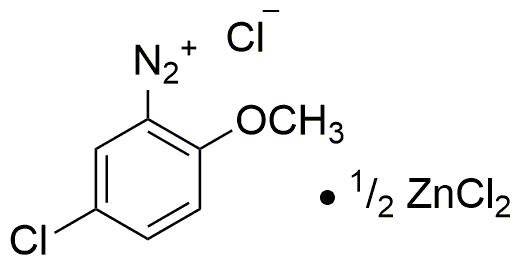Fast Red RC Salt is widely utilized in research focused on:
- Histology and Cytology: This chemical is commonly used as a dye for staining tissues and cells, allowing researchers to visualize cellular structures under a microscope. Its vibrant color enhances contrast, making it easier to identify specific cell types.
- Immunohistochemistry: Fast Red RC Salt serves as a chromogen in immunohistochemical assays, where it helps in detecting antigens in tissue sections. This application is crucial for diagnosing diseases and understanding biological processes.
- Food Industry: It is also utilized as a food colorant, providing a bright red hue to various products. Its stability and safety make it a preferred choice for enhancing the visual appeal of food items.
- Textile Industry: The compound is employed in dyeing processes, particularly for synthetic fibers. Its excellent fastness properties ensure that colors remain vibrant even after washing.
- Research and Development: Fast Red RC Salt is valuable in developing new staining techniques and improving existing methods in laboratories, making it an essential tool for scientists working on innovative projects.
General Information
Properties
Safety and Regulations
Applications
Fast Red RC Salt is widely utilized in research focused on:
- Histology and Cytology: This chemical is commonly used as a dye for staining tissues and cells, allowing researchers to visualize cellular structures under a microscope. Its vibrant color enhances contrast, making it easier to identify specific cell types.
- Immunohistochemistry: Fast Red RC Salt serves as a chromogen in immunohistochemical assays, where it helps in detecting antigens in tissue sections. This application is crucial for diagnosing diseases and understanding biological processes.
- Food Industry: It is also utilized as a food colorant, providing a bright red hue to various products. Its stability and safety make it a preferred choice for enhancing the visual appeal of food items.
- Textile Industry: The compound is employed in dyeing processes, particularly for synthetic fibers. Its excellent fastness properties ensure that colors remain vibrant even after washing.
- Research and Development: Fast Red RC Salt is valuable in developing new staining techniques and improving existing methods in laboratories, making it an essential tool for scientists working on innovative projects.
Documents
Safety Data Sheets (SDS)
The SDS provides comprehensive safety information on handling, storage, and disposal of the product.
Product Specification (PS)
The PS provides a comprehensive breakdown of the product’s properties, including chemical composition, physical state, purity, and storage requirements. It also details acceptable quality ranges and the product's intended applications.
Certificates of Analysis (COA)
Search for Certificates of Analysis (COA) by entering the products Lot Number. Lot and Batch Numbers can be found on a product’s label following the words ‘Lot’ or ‘Batch’.
*Catalog Number
*Lot Number
Certificates Of Origin (COO)
This COO confirms the country where the product was manufactured, and also details the materials and components used in it and whether it is derived from natural, synthetic, or other specific sources. This certificate may be required for customs, trade, and regulatory compliance.
*Catalog Number
*Lot Number
Safety Data Sheets (SDS)
The SDS provides comprehensive safety information on handling, storage, and disposal of the product.
DownloadProduct Specification (PS)
The PS provides a comprehensive breakdown of the product’s properties, including chemical composition, physical state, purity, and storage requirements. It also details acceptable quality ranges and the product's intended applications.
DownloadCertificates of Analysis (COA)
Search for Certificates of Analysis (COA) by entering the products Lot Number. Lot and Batch Numbers can be found on a product’s label following the words ‘Lot’ or ‘Batch’.
*Catalog Number
*Lot Number
Certificates Of Origin (COO)
This COO confirms the country where the product was manufactured, and also details the materials and components used in it and whether it is derived from natural, synthetic, or other specific sources. This certificate may be required for customs, trade, and regulatory compliance.


